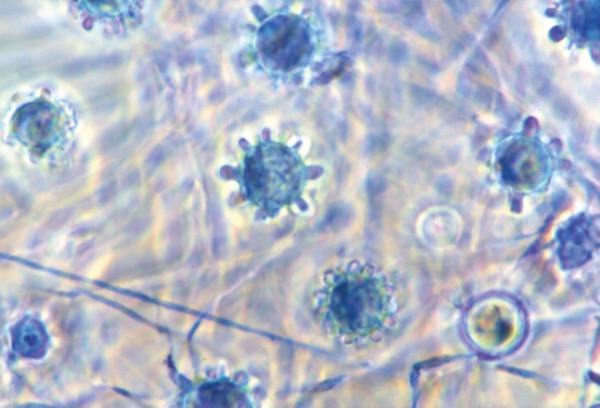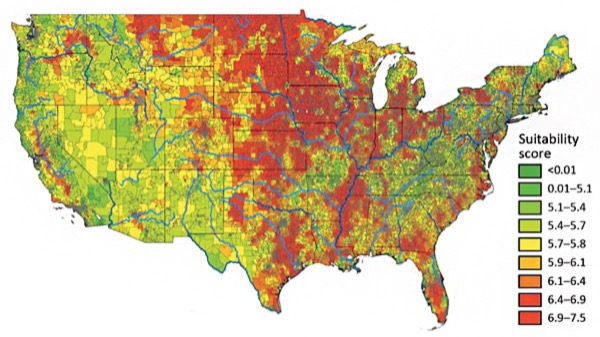Histoplasmosis is a common fungal infection found in river valley areas, but its severity can vary between no symptoms and death if untreated. To help guide physicians in knowing when to take action or not, the Infectious Diseases Society of America (IDSA) has issued four updated recommendations to its guideline that cover the treatment of asymptomatic histoplasma pulmonary nodules (histoplasmomas), mild acute pulmonary histoplasmosis and moderate acute pulmonary histoplasmosis.
“The crux of these guideline updates is that for the vast majority of people with asymptomatic, mild or moderate histoplasmosis, recovery without treatment is the rule. There are very few people with asymptomatic, mild or moderate disease—predominantly those who are immunocompromised—whom I would consider treating,” said Sandra Arnold, MD, the chair of the guideline panel and chief of the Division of Pediatric Infectious Disease at The University of Tennessee Health Science Center and Le Bonheur Children’s Hospital, in Memphis.
Determining Who Needs Treatment
Histoplasmosis is caused by Histoplasma capsulatum, a species of dimorphic fungus found primarily in the central and eastern United States and in Central and South America. Its greatest concentration in the United States is in the Ohio and Mississippi River valleys because of the soil conditions. In fact, one of the largest outbreaks of acute histoplasmosis occurred from 1978 to 1979 in Indianapolis, where 100,000 people were exposed to H. capsulatum.
“We know that most people who live in these hyperendemic regions will have had histoplasmosis in their lifetime because there is a skin test, similar to the skin test for diagnosing tuberculosis,” Dr. Arnold said. “However, it is not used in the diagnosis of patients but for studying the epidemiology of histoplasmosis. It shows that up to 80% of adults living in hyperendemic areas have been exposed at some point.”
Because it is so common, Dr. Arnold said determining who to treat is challenging. Many patients will be asymptomatic, and some will develop mild respiratory symptoms like a cough; but others can develop a severe, life-threatening illness, especially people who are living with AIDS or are immunocompromised in another way. Andrej Spec, MD, MSCI, the vice chair of the guideline panel and director of the Center of Clinical Excellence for Fungal Infections and section chief of transplant infectious disease at the Washington University School of Medicine in St. Louis, noted that “clinically significant histoplasmosis is usually misdiagnosed in more than 80% of patients, and the situation is even more dire when you realize the average number of times that it is missed is three to four.
“It is exceedingly common for patients to come into my clinic having suffered for months or sometimes even up to a whole year with progressive symptoms until they are diagnosed with histoplasmosis,” Dr. Spec said. “At that point, we can still make them better, but so much damage has been done that the road to recovery is long and arduous.”
Having first issued the guideline in 2007, the panel’s updated recommendations are based on systematic literature reviews and the GRADE (Grading of Recommendations Assessment, Development, and Evaluation) approach for assessing the certainty of evidence. The panel included experts in infectious diseases, pediatric infectious diseases, pulmonology, maternal–fetal medicine and pharmacology.
“To help follow the recommendations, we have tables that we spent quite a bit of time preparing that lay out the different stages of the disease and what falls into each category of high, moderate and low levels of immunosuppression,” Dr. Arnold said.
For example, in immunocompromised adults and children with mild or moderate acute pulmonary histoplasmosis who have a moderate to high risk for their disease spreading, antifungal treatment should be strongly considered. Indications of high risk include advanced or untreated HIV/AIDS, having received chimeric antigen receptor (CAR) T-cell therapy within the past 90 days, or undergoing a hematopoietic stem cell transplant within the last 100 days.
However, the panel also suggested against routinely providing treatment to prevent reactivation in patients with known untreated prior infection or asymptomatic non-calcified pulmonary nodules related to histoplasmosis with no evidence of other active sites.
Other recommendations are more open to the clinician’s judgment, particularly in treating moderate disease.
“In the previous guidelines, there is a recommendation to not treat certain groups of certain populations, but there are patients who months or years down the road, actually you have complications as a result of a mild form untreated histoplasmosis,” Dr. Spec said. “What this guideline does is it gives that freedom back to the physicians and their patients to discuss what is right for that individual patient.”
More Data Needed
The guideline also states that additional research is needed on the incidence and timing of the reactivation of histoplasmosis with and without antifungal treatment in different populations, especially during pregnancy and in children.
Other studies should also evaluate the different outcomes between treatment and no treatment in patients at all stages of the disease. Dr. Arnold said one of the challenges with research is creating a large enough patient consortium of individuals with histoplasmosis.
“During the pre–highly active antiretroviral therapy era from the early 1980s to the mid-90s, most of the studies of histoplasmosis were on disseminated disease in people with AIDS because there were suddenly a lot of people presenting with this condition,” she said. “The main issue today is that a lot of these patients are asymptomatic and never come into a clinic for medical attention.”
Even with the challenges, both she and Dr. Spec stressed that investing in research to better understand and treat the disease will improve global health.
“Histoplasmosis now kills more people in Latin America than tuberculosis and yet we still call it rare, even with data that suggests that we are underestimating how much it kills,” Dr. Spec said. “This is a difficult disease that is associated with a lot of mortality and morbidity when advanced, and there are also milder forms where we don’t fully understand their long-term consequences.”
Dr. Arnold reported no relevant financial disclosures. Dr. Spec reported financial relationships with Astellas, Mayne and Scynexis.
{RELATED-HORIZONTAL}

